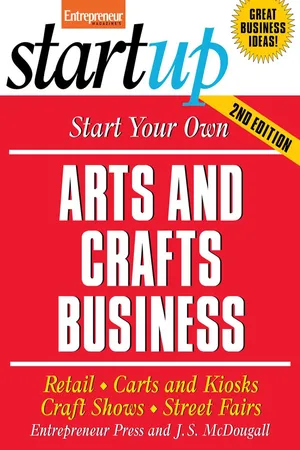![]()
1
Making It Yourself
Assembly lines around the world are churning out mass-produced items that are purchased almost as fast as they can be made. Everything from baskets to furniture to pottery to paintings are being crammed by the ton into container ships and distributed around the world. But consumer acceptance of low-cost, look-alike goods hasn’t eliminated the demand for authentic handcrafted items—although they are likely to have a much different function today than in the past.
Many handcrafted items are now valued as works of art. Historically, though, their value was primarily utilitarian. For example, baskets and pottery were essential for transporting food, water, and other items. Weaving produced fabrics that could be made into clothing and blankets.
The industrial revolution remade our society so that the need for functional handcrafted items is now not as extensive as it once was. But Americans who want quality and authentic artistic and decorative items turn to modern-day craftspeople who produce a variety of items such as jewelry, ceramics, wood carvings, furniture, crocheted and knitted goods, decorated clothing, toys, and much more.
What Are Arts & Crafts Anyway?
Art eludes definition and always has. From writing to pottery and Wordsworth to Picasso, art spans all time and media. Therefore, for the sake of this book, we will be reigning in the definition of art to mean simply artistic crafts meant for decoration. Don’t think of this definition as limiting, think of it as manageable. Under this definition we can still fit, and consider, decorative paintings, needlework, jewelry, wreaths, pins, and plenty more.
In this book, craft refers to any handmade item that can be given as a gift or sold—and if you’ve attended a crafts fair, you may have been surprised by what craftspeople sell and what people are willing to buy. The unpredictability of the crafts market is one of the intriguing and challenging aspects of the business.
Stat Fact
According to the Hobby Industry Association, more than four out of five U.S. households have at least one family member engaged in crafts/hobbies; 77 percent use their crafts as gifts, 71 percent for personal use, 63 percent specifically for home decorating, 47 percent for holiday decorations. Fifteen percent sell their crafts.
In Craft Today: Poetry of the Physical (Grove Press), Paul J. Smith writes, “In its broadest sense craft refers to the creation of original objects through an artist’s disciplined manipulation of material. Historically craft was identified with producing objects that were necessary to life. Modern industrialized society eliminates the need to make by hand essentials for living. The term craft now must be defined in the context of a society that focuses on greater efficiency by technological achievement.”
The question of whether crafts are art or a separate medium may never be definitively answered. In The Crafts of the Modern World, Rose Slivka writes, “Throughout their long history, crafts have produced useful objects which are later considered fine art. Time has a way of overwhelming the functional value of an object that outlives the men who made and used it, with the power of its own objective presence—that life-invest quality of being that transcends and energizes. When this happens, such objects are forever honored for their own sakes—they are art.”
Of course, for someone wanting to start an arts and crafts business, the question of whether the products are art may not be particularly important—though the terms art and craft, and artist and crafter, will be used interchangeably throughout this book. A more critical question is whether or not you can make money.
The nature of the crafts industry makes it difficult to define and quantify, but industry experts estimate that sales revenues exceed $10 billion annually, and hundreds of thousands of working artisans earn their entire income from the crafts they produce.
Most professional craftspeople start making their handcrafted goods as a hobby, and begin selling items to friends and family. From there, they typically expand to selling in crafts shows and fairs several times a year. Sometimes they’re content to keep this as something they do on the side; others are eager to move from part-time to full-time status. Still other artisans tackle their work as a full-time career from the beginning, often renting studio or retail space, or both.
Start-up costs for a crafts business range from literally a few dollars to several thousand dollars, depending on what you are making, what type of equipment and raw materials you need, and whether you already own equipment when you start. Artists and crafters earn as little as a few dollars an hour (for part-time crafters who are not particularly interested in profits) to as much as $20 or $30 an hour and sometimes more if they learn how to market and manage their businesses efficiently.
In the Beginning
Let’s take a look at how some established craftspeople got started: Jay Norman of DeLand, Florida, who makes containers for his business, Organize with Wood, was a dance teacher who had worked with wood as a hobby all his life. He says his wife, Dianne, turned him into a professional craftsperson. “His items were so clever and unusual, I thought he could sell them,” she recalls. So Jay and Dianne quit their jobs in New York in 1997, moved to Florida, and now sell virtually year-round at crafts shows around the country.
Judy Infinger of Altamonte Springs, Florida, makes wood and fabric decorative items, primarily with a Christmas theme, for her part-time business, Woods and Threads, which she started back in 1988. “I just do fall shows, so I concentrate on Christmas items—ornaments, pins, that sort of thing—which are my favorite, anyway,” she says. She builds her inventory throughout the year, then sells at shows during the autumn crafts show season.
Deborah Farish, owner of Dolls by Deb of Manchester, Missouri, makes soft-sculptured dolls as a part-time business and works full time as an administrative assistant in an accounting firm. She has been sewing since she was 12. “I would go to crafts shows, look at dolls, and think, ‘I can do that’—which is what everybody says when they go to a crafts show,” she says. Finally, in 1993, she bought some fabric, made a doll she took into her office as a sample, and began getting orders. With the encouragement of friends and customers, she built an inventory and began exhibiting at crafts shows.
Stat Fact
How much do consumers spend on crafts as gifts? According to the National Craft Association, when the item is for themselves, relatives, or close friends, they spend $20 to $30; when it’s for other adults or children on their gift list, they spend $10 to $20; when it’s a token gift for co-workers, teachers, professional or service providers, they spend $5 to $10.
Gladys Johnson of Bunn, North Carolina, was looking for a hobby when a friend of hers invited her to a doll-making class. “After doing my first doll, I was hooked,” she says. Still, in the beginning, she had no intention of turning her hobby into the business she named Dolls by Gladys. But in 1995 “it got to the point where I had to get rid of some of the dolls so I could make more,” she explains. She makes porcelain dolls, most with cloth bodies (although she has made some with porcelain bodies).
Lynn Korff, owner of Korff’s Ceramic Originals in Cabot, Pennsylvania, had been making ceramics for about six years when she opened her own studio and shop where she made ceramics, held classes and sold supplies. Eleven years later, she decided to downsize: She closed the shop, moved her business home and set up a web site in 1999 to sell her crafts. Her primary product is piggy banks, but she also makes and custom paints other ceramic items, such as dinnerware, flower pots, candle holders, serving dishes, and specialty plates.
Bright Idea
Before you leap from hobby to business, take an informal poll of your friends. Ask them how much they would expect to pay (not if they would buy) for your crafts. That will give a very unscientific idea of your potential price point and whether or not you’ll be able to recover your material costs and still make a profit.
A love of candles prompted Melony Bell of Fort Meade, Florida, to start making them as a hobby. She wasn’t satisfied with the quality of candles available in stores. Her husband is a beekeeper, so she started using his beeswax to make her own candles. After she gave a few as gifts, people started asking if they could buy her candles. So, in 1998, with a full-time job as an auditor with the Florida Division of Motor Vehicles and serving as city commissioner /mayor for her town, she started her own candle-making company.
A Day in the Life
A typical day for a part-time craftsperson will, of course, differ significantly from that of a full-time crafter. Many part-time crafters have full-time jobs they must work around. Typically, crafters who exhibit in shows spend their weekdays making their products and their weekends at shows.
Deb Farish of Dolls by Deb in Manchester, Missouri, says finding the time to do it all is her biggest challenge. “Beyond sitting at a craft show for eight hours on a Saturday and Sunday, there’s trying to juggle a full-time job, raising children and their pets, the laundry, watering the plants, and then finding a few hours to spend at the sewing machine or hot glue center, or whatever you need to do. It’s very difficult.”
There’s much more to having a crafts business than simply making the items. You need to allow time to shop for and purchase your raw materials. You’ll also need to spend time doing research to determine which crafts shows are best for you, and putting together the applications to exhibit in those shows. You need to develop and implement an effective marketing plan. And, of course, there’s administration: record-keeping, maintaining the required licenses and permits, payroll (if you have employees), taxes, and so on. These are not tasks that craftspeople are typically good at or enjoy. But they must be done.
If it sounds like a crafts business is hard work, it is. What’s more, it’s not an industry with wide profit margins. So why do it? Deb says, “It’s fun, it’s relaxing. I’m a happy person, but I’m even happier because I can create something, make somebody smile, touch somebody by what I have made. And if somebody likes it enough to buy it and give it to someone else, or put it in their own home—that’s such a kick.”
Anita Fetter of Waynesfield, Ohio, has been making and selling wood and fabric crafts since 1980. She started working with her husband, who made wood items that she painted or stained; she also did cross-stitch, knitted, and made stuffed animals. But as their hobby turned into a business, her husband backed out of it. “He stopped when it got to be a job,” she says. “Now I do most of it and just make things for the fall and winter.”
What these crafters and many others have found is that while selling their handcrafted goods is often fairly easy, the challenge is making a profit. You need to decide what to make, determine if there is a sufficient market for that item, then figure out if you have the wherewithal to reach that market. Just because your family members appreciate your handmade gifts, and your co-workers are willing to buy modestly priced items from you doesn’t necessarily mean you can sell enough of them at a price that will justify your investment of materials and time. On the other hand, friends and family may be just the proverbial tip of the iceberg, and you may have a product that will become the foundation for a thriving company.
Beyond that is the issue of running a business. Just because you love doing a particular craft doesn’t mean you’ll love doing all the things that go with running a crafts business. Of course, you don’t have to love them, but you do have to do them.
dp n="18" folio="7" ?
![]()
2
Taking the First Steps
The first step is, of course, deciding what crafts you’re going to make. It’s a choice that is entirely up to you. Chances are, you already have an idea of the type of crafts you want to do, but let’s take a look at the more popular ones:
• Ceramics. Ceramists most commonly make vases and mugs, but you can also make dishes, plaques, ornaments, and other items.
• Floral crafts. These comprise any items made from artificial or dried flowers, including table arrangements, wall decorations, and bouquets.
• Candle-making. Candles are popular and consumable, which means your customers use them and come back to you for more.
• Jewelry. You can make all types of jewelry—rings, necklaces, bracelets, earrings, and items for various body parts—in any price range using a variety of materials.
• Sewing. Sewn crafts include a broad range of items, such as clothing, stuffed animals, home furnishings, and linens.
• Needlecraft. Needlecraft includes cross-stitch and needlepoint. You can make wall hangings, table runners, holiday decorations, napkins, and tablecloths.
• Crocheting and knitting. You can crochet and knit various items, such as blankets, clothing, and decorative accessories.
• Woodworking. You can make a wide range of items from wood, including toys, furniture, and various decorative items.
• Wood carving. Wood-...



